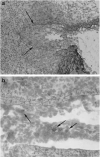Emerging role of B cells in chronic allograft dysfunction
- PMID: 21116310
- PMCID: PMC4341830
- DOI: 10.1038/ki.2010.436
Emerging role of B cells in chronic allograft dysfunction
Abstract
B cells have many possible mechanisms by which they can affect allograft survival, including antigen presentation, cytokine production, immune regulation, and differentiation into alloantibody-producing plasma cells. This report reviews the last mechanism, which the authors regard as most critical for the long-term survival of allografts, namely, the promotion of chronic rejection by alloantibodies. Chronic humoral rejection characteristically arises late after transplantation and causes transplant glomerulopathy, multilamination of peritubular capillary basement membranes, and C4d deposition in PTCs and glomeruli. Circulating antidonor human leukocyte antigen class II antibodies are commonly detected and may precede the development of graft injury. Prognosis is poor, especially when recognized after graft dysfunction has developed. Improved detection and treatment are critically needed for this common cause of late graft loss.
Figures


References
-
- Jeannet M, Pinn VW, Flax MH, et al. Humoral antibodies in renal allotransplantation in man. N Engl J Med. 1970;282:111–117. - PubMed
-
- Terasaki PI, Ozawa M, Castro R. Four-year follow-up of a prospective trial of HLA and MICA antibodies on kidney graft survival. Am J Transplant. 2007;7:408–415. - PubMed
-
- Worthington JE, Martin S, Al-Husseini DM, et al. Posttransplantation production of donor HLA-specific antibodies as a predictor of renal transplant outcome. Transplantation. 2003;75:1034–1040. - PubMed
-
- Halloran PF, Wadgymar A, Ritchie S, et al. The significance of the anti-class I antibody response. I. Clinical and pathologic features of anti-class I-mediated rejection. Transplantation. 1990;49:85–91. - PubMed
-
- Trpkov K, Campbell P, Pazderka F, et al. Pathologic features of acute renal allograft rejection associated with donor-specific antibody. Analysis using the Banff grading schema. Transplantation. 1996;61:1586–1592. - PubMed
Publication types
MeSH terms
Substances
Grants and funding
LinkOut - more resources
Full Text Sources
Medical

